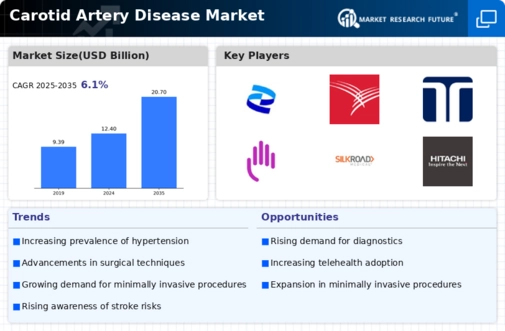Market Trends
Key Emerging Trends in the Carotid Artery Disease Market
The market for carotid artery disease treatment is undergoing significant shifts driven by advancements in medical technology, changing demographics, and evolving healthcare policies. One key trend in this market is the growing adoption of minimally invasive procedures for the treatment of carotid artery disease. Minimally invasive techniques such as carotid artery stenting (CAS) offer a less invasive alternative to traditional carotid endarterectomy (CEA), reducing patient recovery times, complications, and healthcare costs. As a result, there is increasing interest among healthcare providers and patients in minimally invasive treatment options, driving the demand for CAS procedures.
Moreover, there is a growing emphasis on personalized medicine approaches in the treatment of carotid artery disease, tailored to individual patient characteristics and risk profiles. With advances in medical imaging, genetics, and biomarker research, healthcare providers can better stratify patients based on their likelihood of stroke and cardiovascular events, allowing for more targeted interventions and treatment decisions. Personalized medicine approaches include optimizing medical therapy, selecting the most appropriate revascularization procedure (CAS or CEA), and implementing risk factor modification strategies to improve patient outcomes and reduce the risk of recurrent events.
Furthermore, technological advancements in endovascular devices and imaging techniques are driving innovation in the carotid artery disease treatment market. Manufacturers are developing next-generation stents, embolic protection devices, and catheter-based systems that offer improved safety, efficacy, and ease of use for CAS procedures. Additionally, advances in imaging modalities such as duplex ultrasound, magnetic resonance angiography (MRA), and computed tomography angiography (CTA) enable precise pre-procedural planning, intraoperative guidance, and post-procedural surveillance, enhancing the success rates and long-term outcomes of carotid artery interventions.
Another notable trend in the carotid artery disease treatment market is the increasing focus on secondary prevention strategies to reduce the risk of recurrent stroke and cardiovascular events. Healthcare providers are emphasizing aggressive management of modifiable risk factors such as hypertension, hyperlipidemia, diabetes, and smoking, which are associated with an increased risk of carotid artery disease progression and adverse outcomes. This includes optimizing medical therapy with antiplatelet agents, statins, antihypertensive medications, and lifestyle modifications to control blood pressure, cholesterol levels, and blood glucose levels, thereby reducing the overall burden of atherosclerosis and preventing future cardiovascular events.
Moreover, there is growing recognition of the importance of multidisciplinary care and collaboration among vascular specialists, neurologists, interventional cardiologists, and primary care providers in the management of carotid artery disease. Integrated care pathways, multidisciplinary clinics, and coordinated follow-up care are being implemented to ensure comprehensive evaluation, treatment, and long-term management of patients with carotid artery disease. This team-based approach facilitates shared decision-making, continuity of care, and holistic management of patients' cardiovascular risk factors and comorbidities, leading to improved patient outcomes and quality of life.
Additionally, regulatory changes and healthcare policies are influencing the carotid artery disease treatment market, particularly in terms of reimbursement policies, quality metrics, and guidelines for stroke prevention and management. Healthcare systems are increasingly adopting value-based reimbursement models and performance metrics that incentivize high-quality, cost-effective care and reward positive patient outcomes. This includes adherence to evidence-based guidelines for carotid artery revascularization, appropriate use criteria for imaging studies, and standardized protocols for perioperative care and follow-up monitoring, ensuring consistency and quality across different healthcare settings.









Leave a Comment